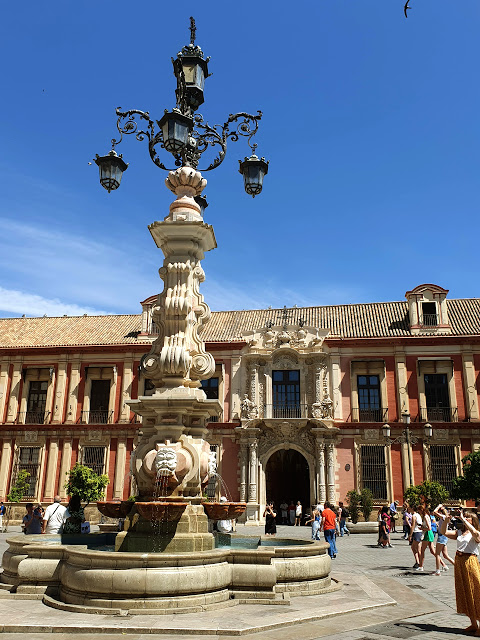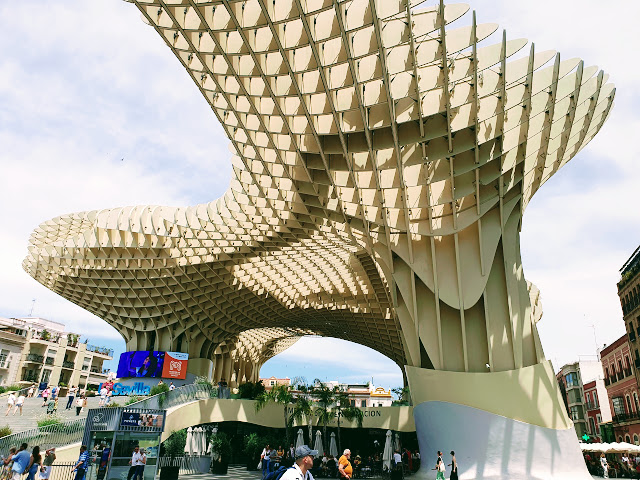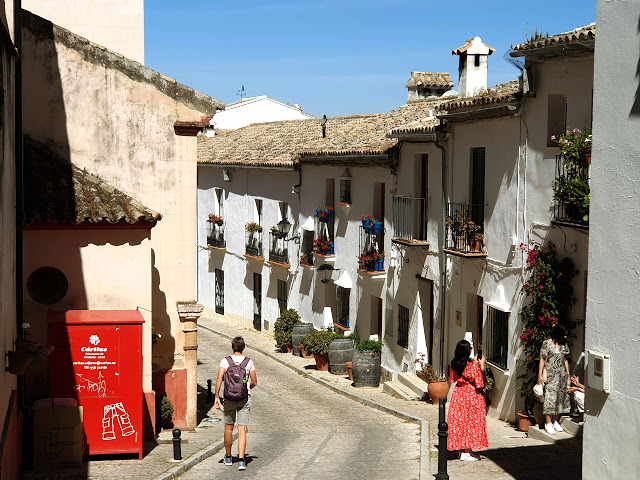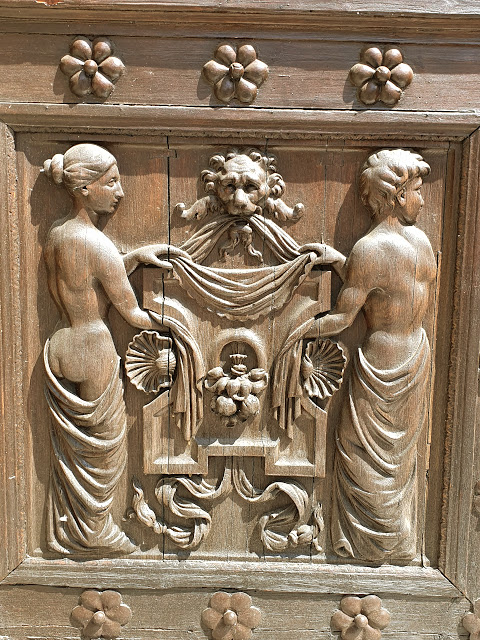The flight from Charles de Gaulle aiport in Paris was relatively straight foward arriving in Seville around 5pm. Whereas Paris was 15C, Seville was 31C but no humidity like Singapore. Followed the trusty Google map for the various bus stations/stops to the Centro of Seville where our apartment is. Another wee gem that has all we need. Got sorted, found the supermercardo then a local tapas bar for dinner. One can choose from a selection of small dishes for about 4-5 euros each.
First full day we hit the streets early for a self guided walk about. The Triana neigbourhood was originally a workers area known for ceramics. Has a huge undercover food market which sits on an old castle, and is beside the Guadalquivir River. It was a glorious Saturday morning so plenty of activity.
Rowing both women and men with the wee speed boat passengers yelling instructions. Reminded us of "boys in the boats" movie we had watched on Singapore Airlines
Castille de San Jorge 15th century as you cross the Puente de Isabel bridge. Triana used to be known as the wrong side of the bridge.
Said market on old castle remains. This is a novel way to serve cheeses, cured ham, strawberries.
Display is everything.
Religion has made Seville what is. After the Romans left the Muslim ensured the town flourished from 711AD. It was then conquered by the Christians in 1248, with Muslim and Jews driven out. Many of the buildings still reflect the Muslim or Moors influences.
Novel afternoon sun heat deflector.
The ostentatious buildings do become overwhelming but for the sheer brilliance of the artisans.
Torre norte of the Plaza de Espana
Casino de la Exposicion
Streets are not too busy and pIenty of shade. We have noted that the Cafe culture of Seville is not as strong as Paris, more bars than sitting on a coffee all day. Metro is limited but an adequate bus service. Most folks walk as the old central area is small enough. Buying a baguette with dried ham, Jambon, is deurigour lunch for toursts like us but would have to say the Spanish cannot make croissants. Hospo staff generally very helpful even after having to listen to my beginners Spanish. Still not used to the smoking everywhere though as in Paris, we are light years ahead in NZ.
Fabulous alleyways lead off everywhere. Very clean in the city area, like Paris, with city staff constantly keeping up the standard. The "Broken window theory" works, keep it nice and the inhabitants respect it.
Stumbled across a 12th century covenant/church with the nuns hard out singing. The opulence is what kept the parishioners poor.
Seville only gets about 80 days of rain in a year. With high sunshine hours, 2890 pa, solar power makes up only 10% electricity generation, wind 25% and the rest oil/gas from Russia. They are trying to increase the solar power percentage but we do not see many buildings with panels on the roofs.
Population of Spain is 55 million on a land mass twice the size of NZ. Therefore not too excited about giving over land to solar farms.
Called the Setas made mostly from laminated wood in a 6 mushroom/parasol shape 150m x 70m each at 26m high. Has 4 floors, of which the observation deck at the top, it is popular.
Recommended by various friends one MUST go to flamenco when in Seville which we duly did. Having seen Fado in Portugal we left feeling that flamenco was a cross between tap dancing and Fado or vice versa. Very fit, lots of foot stamping by enthusiastic dancers and Fado wailing/ singing by the two singers.
Next day we hopped on a bus to what are known as the White Villages of Zahara, Grazalema and Ronda, 2hrs south of Seville. The town of Ronda being the most well known.
White to keep off the heat, well some of it. 50C is reached here in the summers.
The terracing is olive trees. Spain processes 40% the the worlds olives. We wondered who or how they pick them all. In this area family run "farms" with antiquated machinery.
Last year had the lowest rainfall in 80 years i.e since the end of WW2. This dam is only 20% full. We wonder if the present solar flares will change the climate as they have done in previous centuries.
Ronda is built on a deep canyon that divides the town. A bridge joining the divide built in 1616 is still in use. The bull or El Toro in most towns. This one in Grazalema.
Ronda has the oldest bull fighting ring in Spain built 1784.
Although we do not agree with bull fighting the symbols of this Spanish passion were impressive. Note the lady with the fan, even chaps use them when 32C afternoons.
Looking down from the town bridge Ronda.
The white hilltop villages reminded us of our time in Italy 2019 staying in Monterchi.
Getting on to 4pm time for a cold drink in front of the town church where a family were finishing lunch, 3 hours at least, in anticipation of a Mothers day mass all dressed up. Mass started at 5.30pm and it seemed most of the town were making their way there in all their finery.
These small people were having so much fun on the church steps awaiting the next afternoon instalment of proceedings. Note the separation of the genders per iPhone.
Today, Monday, we had pre-ordered tickets to the Alcazar in Seville. An early start and the day of choice ensured not too crowded. The ticket buying line can be over two hours wait and then they only allow a limited number of entries.
The Alcazar dates from the 10th century built by Muslims, who ruled Spain from 711AD until 1492. Alcazar was given a make over in the 14th century and then further works after the Lisbon earthquakes of 1531 and 1755 that devastated the Iberian peninsula of which Seville is part of. It still functions as a royal palace, one of the oldest in Europe.
Entrance to the Alcazar is the Puerto de Leon. Buying a ticket is around the corner and only those with a pre-ordered ticket could be here. This trips up many tourists and once the rather officious security chap sends them on their way find they now have at least a two hour wait to obtain tickets for maybe later in the day, if at all.
Courtyard of the Maidens with reflective pond.
Carved in pine the Arab influence dominates.
Carved stonework was very inticate. Ceilings sees one gaping like a fish staring up at them.
Calming influence of water and gardens
King Ferdinando and Queen Isabella of Spain were known as the Catholic monarchs. Expelling the Muslims and Jews, unifying a Christian Spain and financing Christopher Columbus expedition to the New Worlds....not the supermarket.
The ceramic tiles, thousands of them were amazing. So much detail. The various earthquakes repairs noticeable on some murals.
In the hall of tapestries there were at least ten tapestries reflecting the Battle of Tunisa. Absolutely enormous at we thought 12m x 8m each. Yet another Lisbon earthquake, this time in 1755, completely destroyed the hall so the then King of Spain, Philip V, had exact replicas made. I am trying to translate Latin to English via google with not much sucess.
Such detailed carving tells a story that if a script is available can be understood. Like so much of history often the interpretation of many antiquities were lost to fire, earthquakes or ransackings from invaders.
Jeff contines to be entranced by large doors, no pun intended.
A classic Moorish building with the utilitarian new modern to the right.
These young girls cut quite a colourful sight as they trialled behind Mum to whatever was happening.
One can only take so much opulence, history and scale in a days walking about Seville.
Tomorrow we have tickets to the Seville Cathedral, one of the largest Gothic churches in the world.




















































No comments:
Post a Comment